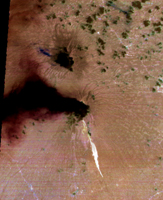ASTER Images Merapi's Continuing Eruption
 |  |
| Daytime Visible Image | Thermal Infrared Image |
On Oct. 26, 2010, Merapi volcano in Indonesia erupted, killing more than 270 people to date and prompting authorities to evacuate tens of thousands of inhabitants from around the mountain. On Nov. 15, 2010, the Advanced Spaceborne Thermal Emission and Reflection Radiometer (ASTER) instrument on NASA's Terra spacecraft captured images of the cooling, but still hot volcanic flows that resulted from collapse of the summit lava dome, and an active ash plume ash. In this daytime visible image (left), vegetation is displayed in green; the recent volcanic flow is in gray, visible in the drainage on the south flank of Merapi; and ash clouds are visible to the west and north of the volcano. The thermal infrared image (right) has been processed to reveal the dominant presence of volcanic ash in the eruption plume and clouds, displayed in dark red. The warm volcanic flow appears bright. The ASTER image is located at 7.5 degrees south latitude, 110.5 degrees east longitude. The image covers an area of 32 by 40 kilometers (20 by 25 miles).
With its 14 spectral bands from the visible to the thermal infrared wavelength region and its high spatial resolution of 15 to 90 meters (about 50 to 300 feet), ASTER images Earth to map and monitor the changing surface of our planet. ASTER is one of five Earth-observing instruments launched Dec. 18, 1999, on Terra. The instrument was built by Japan's Ministry of Economy, Trade and Industry. A joint U.S./Japan science team is responsible for validation and calibration of the instrument and data products.
The broad spectral coverage and high spectral resolution of ASTER provides scientists in numerous disciplines with critical information for surface mapping and monitoring of dynamic conditions and temporal change. Example applications are: monitoring glacial advances and retreats; monitoring potentially active volcanoes; identifying crop stress; determining cloud morphology and physical properties; wetlands evaluation; thermal pollution monitoring; coral reef degradation; surface temperature mapping of soils and geology; and measuring surface heat balance.
The U.S. science team is located at NASA's Jet Propulsion Laboratory, Pasadena, Calif. The Terra mission is part of NASA's Science Mission Directorate, Washington, D.C.
More information about ASTER is available at http://asterweb.jpl.nasa.gov/.
